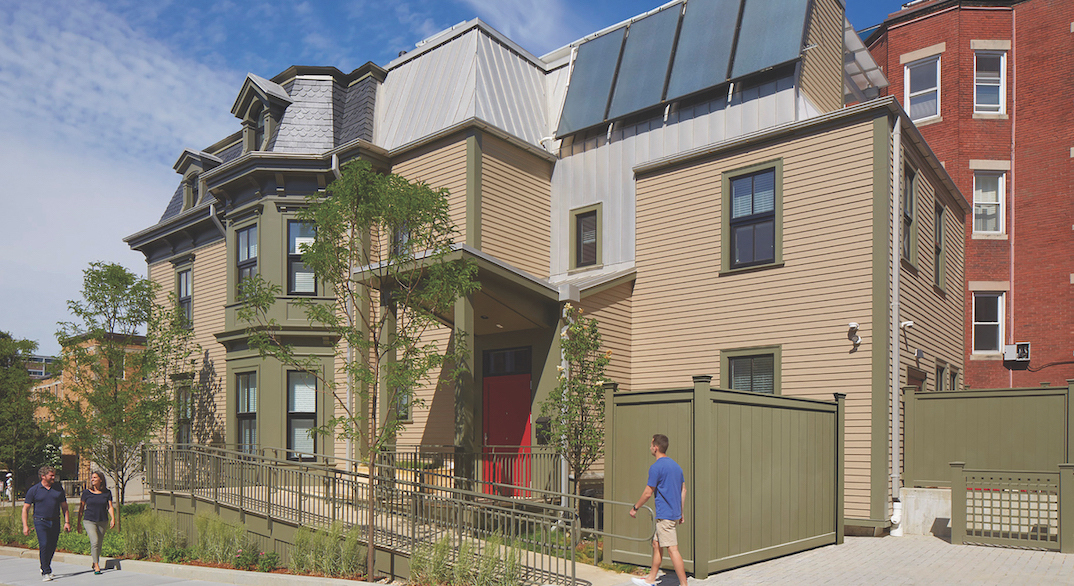Two years ago, Cambridge, Mass., adopted ambitious net-zero energy standards for the construction and renovation of city-owned properties. One of the first projects to fall under this rubric was an 1885 Victorian home at 859 Massachusetts Avenue. The 7,500-sf structure, which was being used as office space, has since been refashioned into a 10-unit shelter for homeless families.
The LEED Gold–certified structure has been operating at “near-net-zero” energy use. Because Cambridge has a strong historic preservation ethos, the project team had to carefully balance energy conservation with the preservation of historical integrity.
The facility replaced a deteriorating structure of similar age and size. “Fortunately, this house was solidly built,” said Lori Cowles, AIA, President of HMFH Architects, the design firm on the project. But its faded aluminum siding, jerry-built front entryway, rusting fire escapes, and paved-over gardens were obvious signs of decline.
The building needed extensive work to be made suitable for modern residential use. The City of Cambridge invested $5 million of city tax dollars in the renovation. “The city believed that the residents deserved a beautiful space,” said Ellen Semonoff, Assistant City Manager, Human Services.
Demolition revealed unexpected structural deficiencies. Floorboards, joists, and sections of flooring were rotted. “The flooring had some hand-hewn boards that were not standard-sized,” said Brendon Roy, Project Manager for the city. “They had to be shimmed or cut down to make them work.” New footings were poured to reinforce the structure. The rubble foundation required extensive patching.
A MAJOR SETBACK, A NEW OPPORTUNITY FOR MULTIFAMILY HOUSING
One of the keys to reaching net zero was to install a geothermal heating/cooling system. But two attempts to drill 900-foot wells on site resulted in nothing but broken drill bits. At this point construction was well under way, so the city decided to drop the geothermal option.
That turned out to be a blessing. The mechanical engineer, Garcia, Galuska & DeSousa, substituted variable refrigerant flow technology with an above-ground air-to-water cooler. “The efficiency on this system turned out to be better than a geothermal well,” said Roy.
A generously insulated, tight envelope was critical to achieving net-zero energy efficiency. The thickness of exterior walls was doubled so that a six-inch layer of continuous mineral wool outboard of the studs could be applied. Four inches of cellulose insulation was blown in between the studs. The interior of the foundation was insulated with 4½ inches of closed-cell spray foam.
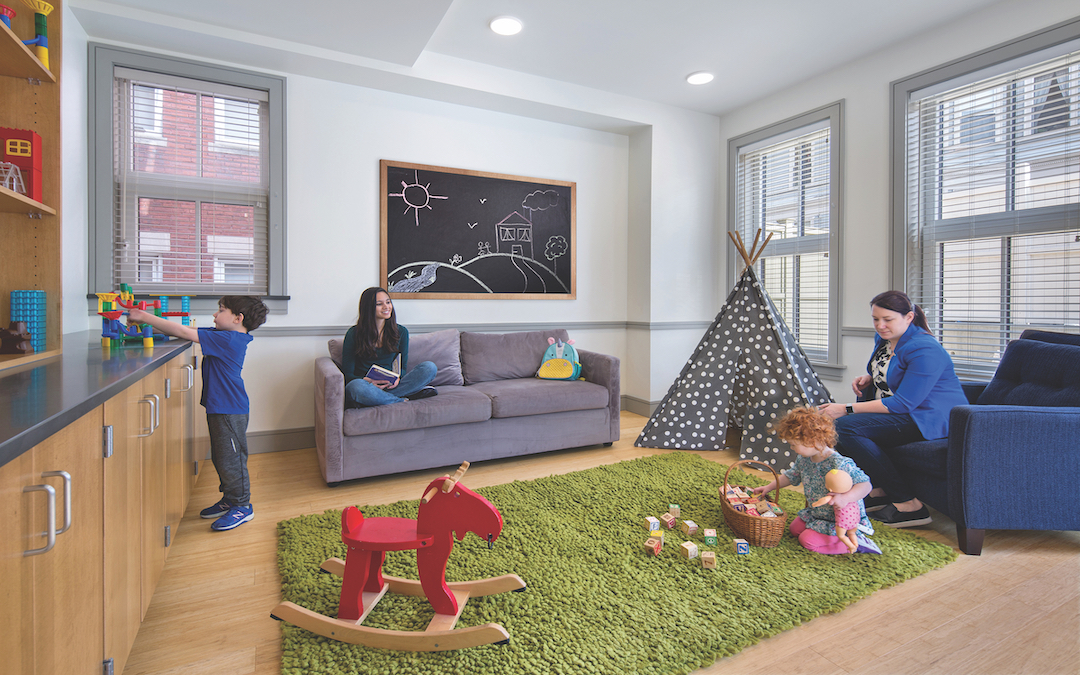 Children share a playroom at Renae’s Place. There’s also a play structure in the backyard. Horizons for Homeless Children hosts a play space weeknights to give parents time to work on job applications and résumés. YWCA Cambridge provides social services and manages the property for the city. Photo: Ed Wonsek
Children share a playroom at Renae’s Place. There’s also a play structure in the backyard. Horizons for Homeless Children hosts a play space weeknights to give parents time to work on job applications and résumés. YWCA Cambridge provides social services and manages the property for the city. Photo: Ed Wonsek
Eight inches of cellulose insulation was blown in between the roof rafters, and five inches of rigid extruded polyisocyanurate was installed under a section of flat roof.
Zola Thermo-Clad doors and windows from Germany, made with aluminum-clad wood and triple-glazed with a low-e coating, yielded an R-7 insulation value. “They are better insulated than any other doors and windows—almost three inches thick,” said Roy. “This was bleeding-edge technology, and because they were sourced from Germany, there were longer lead times. But this was something we needed to do to get to net zero, even if it will take 30 years to pay off.”
Final energy use calculations for the first year were not available at this writing. Based on available data, the structure has a predicted site energy use intensity of 17.02 kBtu/sf/year compared to 59.6 site EUI for a typical multifamily building of this type.
HISTORICAL COMMISSION PROVES FLEXIBLE FOR THIS MULTIFAMILY DEVELOPMENT
The Cambridge Historical Commission, which was involved from the early design stage, was open to accepting less than total historic accuracy in some cases. “Cambridge has a wealth of homes from different time periods,” said Cowles. “This is not a one-of-a-kind for the city.” Even though the imported tilt-turn windows were not historically accurate, the commission acknowledged that their tight-sealing capability was crucial to the success of the net-zero energy scheme.
The commission also approved cellular PVC cornices and trim that looked close enough to the original wood from a distance and would be more durable than wood. After the aluminum siding was removed, new clues were revealed. “We could see ghosts of architectural details,” said Cowles. This shadowing helped in the selection of historically accurate exterior features.
Being true to the original design required extensive detective work. “Many of the buildings on the block from that era were gone,” said Cowles. HMFH designers pored over old photographs of the property to help choose appropriate detail features. “We were lucky that the city’s historical commission keeps good records,” said Cowles.
Built during the late Victorian period, the original structure was not as ornate as those constructed in the high Victorian era, “with all the bells and whistles,” said Cowles. Research showed that bright tones were not available at that time, so a muted tan and green color scheme was chosen.
Putting solar panels on roofs is almost always prohibited in historic building projects, but the project team got lucky. “Due to the shape of the roofline, you can’t see the panels from the street, so we were able to put panels on the roof,” said Cowles. Solar thermal collectors mounted to the roof provide hot water.
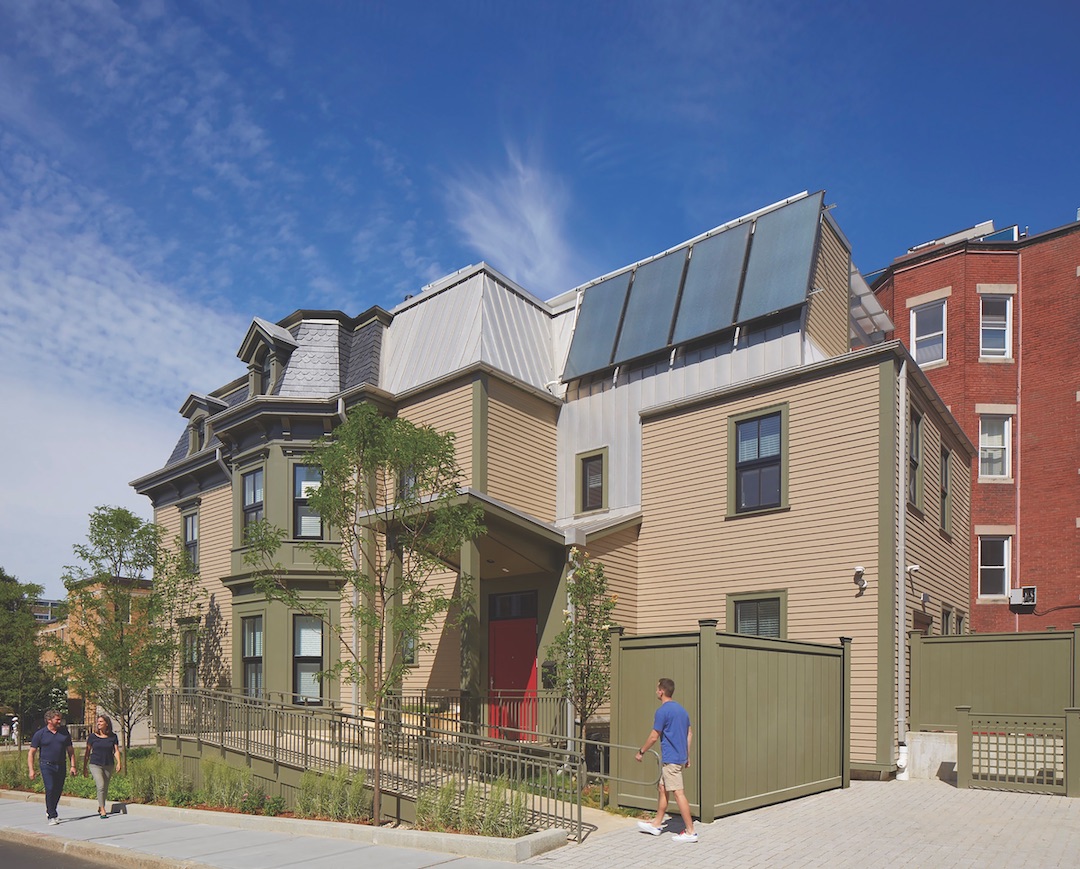 Rather than try to dress up a nonconforming late addition (at right in photo) in Victorian style, designers left it looking pretty much as is and hung photovoltaics at the roof level. PVs on the roof of the original mansion were permitted by the historical commission because they were obscured from street view. Photo: Bruce T. Martin
Rather than try to dress up a nonconforming late addition (at right in photo) in Victorian style, designers left it looking pretty much as is and hung photovoltaics at the roof level. PVs on the roof of the original mansion were permitted by the historical commission because they were obscured from street view. Photo: Bruce T. Martin
The PVs are capable of generating 15.51 KW. But because the local utility does not allow PV systems in this area to export power back to the grid, the property cannot benefit from net metering, and thus does not reap the full benefit of its solar-generating capacity.
The structure probably would have achieved its net-zero goal but for the restriction preventing net metering and the need to put a refrigerator in every unit.
The shelter opened in June 2018. Residents, primarily homeless women and their children, typically spend about 18 months in the facility while they wait for more permanent housing. The upgrades include two units for residents with disabilities.
The units range in size from 220 to 260 sf and can accommodate an adult and one or two children—a tight fit, but better than the alternative. Interiors feature solid surface Caesarstone countertops and LED lighting with sensor technology. There are group kitchens with energy-efficient induction cooktops and dining areas on each floor. Children share a playroom as well as a backyard with a play structure. A private room affords space to case managers from YWCA Cambridge, which manages the building under contract with the city, for confidential meetings with residents about social services.
Aesthetically, the historically reverential restoration is now seen as an asset to the neighborhood instead of a blight. It was named Renae’s Place, for Renae Gray, a longtime activist affiliated with the YWCA. “She died a year before it opened,” said Semonoff. “It embodies her spirit.”
PROJECT TEAM | RENAE’S PLACE
CLIENT City of Cambridge, Mass.
PROPERTY MANAGER YWCA Cambridge
ARCHITECT HMFH Architects
MECHANICAL ENGINEER Garcia, Galuska & DeSousa
GENERAL CONTRACTOR Homer Contracting
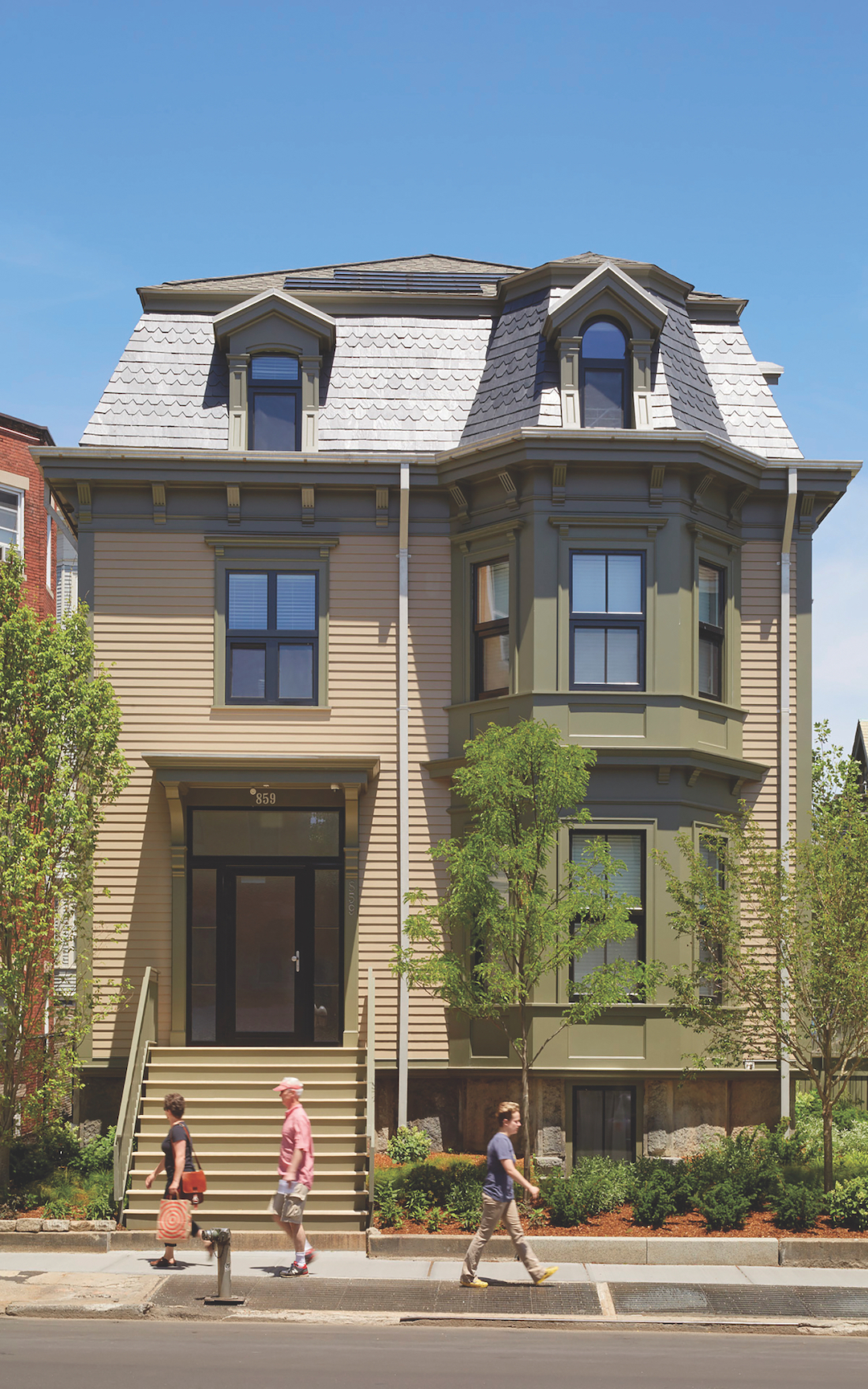 Photo: Bruce T. Martin
Photo: Bruce T. Martin
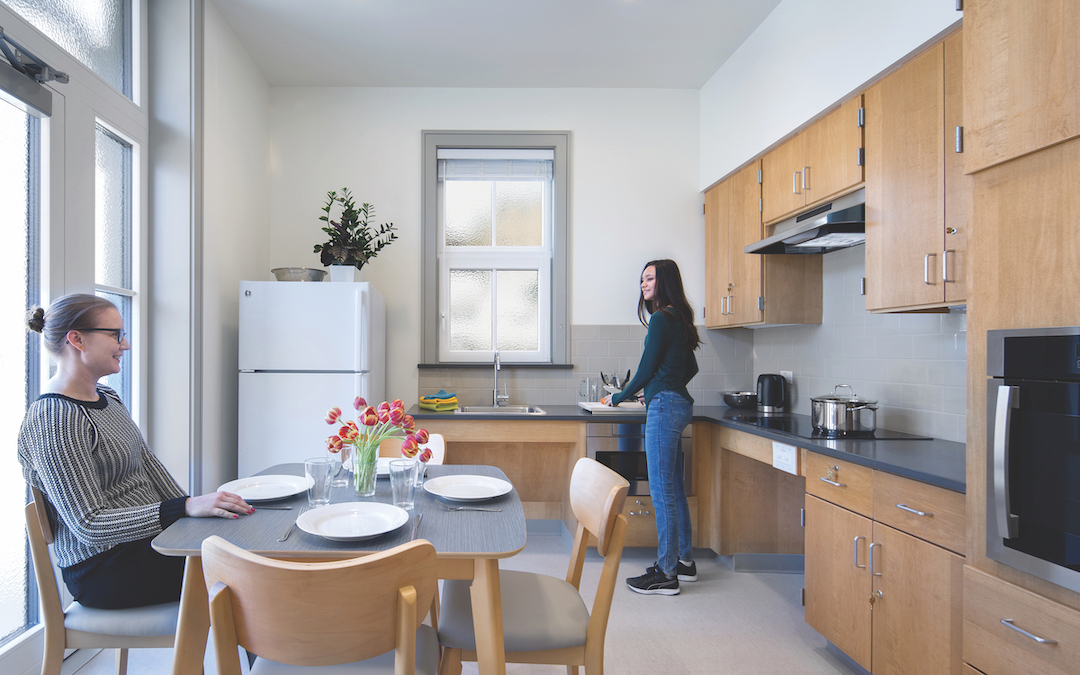 Photo: Ed Wonsek
Photo: Ed Wonsek
Related Stories
Multifamily Housing | May 8, 2023
The average multifamily rent was $1,709 in April 2023, up for the second straight month
Despite economic headwinds, the multifamily housing market continues to demonstrate resilience, according to a new Yardi Matrix report.
Multifamily Housing | May 1, 2023
Survey of apartment residents shows support for property-provided smart home devices for security, energy savings
Multifamily housing residents receive broadband services faster if they are provided by the property management rather than acquiring such service on their own.
Multifamily Housing | May 1, 2023
A prefab multifamily housing project will deliver 200 new apartments near downtown Denver
In Denver, Mortenson, a Colorado-based builder, developer, and engineering services provider, along with joint venture partner Pinnacle Partners, has broken ground on Revival on Platte, a multifamily housing project. The 234,156-sf development will feature 200 studio, one-bedroom, and two-bedroom apartments on eight floors, with two levels of parking.
Codes and Standards | May 1, 2023
Hurricane Ian aftermath expected to prompt building code reform in Florida
Hurricane Ian struck the Southwest Florida coastline last fall with winds exceeding 150 mph, flooding cities, and devastating structures across the state. A construction risk management expert believes the projected economic damage, as high as $75 billion, will prompt the state to beef up building codes and reform land use rules.
| Apr 28, 2023
$1 billion mixed-use multifamily development will add 1,200 units to South Florida market
A giant $1 billion residential project, The District in Davie, will bring 1.6 million sf of new Class A residential apartments to the hot South Florida market. Located near Ft. Lauderdale and greater Miami, the development will include 36,000 sf of restaurants and retail space. The development will also provide 1.1 million sf of access controlled onsite parking with 2,650 parking spaces.
Mixed-Use | Apr 27, 2023
New Jersey turns a brownfield site into Steel Tech, a 3.3-acre mixed-use development
In Jersey City, N.J., a 3.3-acre redevelopment project called Steel Tech will turn a brownfield site into a mixed-use residential high-rise building, a community center, two public plazas, and a business incubator facility. Steel Tech received site plan approval in recent weeks.
Multifamily Housing | Apr 27, 2023
Watch: Specifying materials in multifamily housing projects
A trio of multifamily housing experts discusses trends in materials in their latest developments. Topics include the need to balance aesthetics and durability, the advantages of textured materials, and the benefits of biophilia.
Concrete Technology | Apr 24, 2023
A housing complex outside Paris is touted as the world’s first fully recycled concrete building
Outside Paris, Holcim, a Swiss-based provider of innovative and sustainable building solutions, and Seqens, a social housing provider in France, are partnering to build Recygénie—a 220-unit housing complex, including 70 social housing units. Holcim is calling the project the world’s first fully recycled concrete building.
Multifamily Housing | Apr 21, 2023
Arlington County, Va., eliminates single-family-only zoning
Arlington County, a Washington, D.C., community that took shape in the 1950s, when single-family homes were the rule in suburbia, recently became one of the first locations on the East Coast to eliminate single-family-only zoning.
Green | Apr 21, 2023
Top 10 green building projects for 2023
The Harvard University Science and Engineering Complex in Boston and the Westwood Hills Nature Center in St. Louis are among the AIA COTE Top Ten Awards honorees for 2023.


